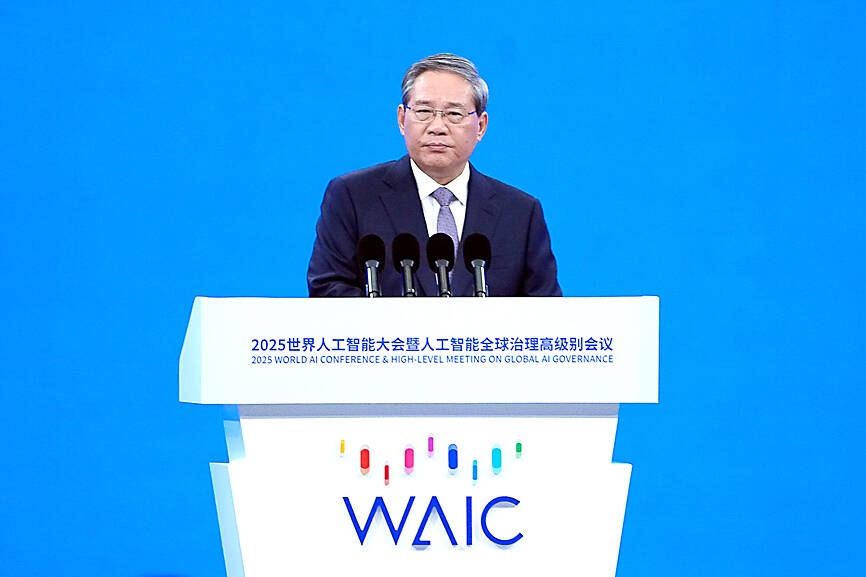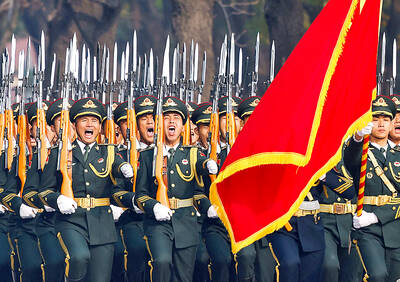Chinese Premier Li Qiang (李強) yesterday warned that artificial intelligence (AI) development must be weighed against the security risks, saying global consensus was urgently needed even as the tech race between Beijing and Washington shows no sign of abating.
Opening the World AI Conference (WAIC) in Shanghai yesterday, Li emphasized the need for governance and open-source development, announcing the establishment of a Chinese-led body for international AI cooperation.
“The risks and challenges brought by AI have drawn widespread attention... How to find a balance between development and security urgently requires further consensus from the entire society,” Li said.

Photo: Bloomberg
The organization would “promote global governance featuring extensive consultation, joint contribution and shared benefits,” Chinese state news agency Xinhua reported, without elaborating on its set-up or mechanisms.
At a time when AI is being integrated across virtually all industries, its uses have raised major questions, including about the spread of misinformation, its impact on employment and the potential loss of technological control.
In a speech at WAIC, Nobel Prize-winning physicist Geoffrey Hinton compared the situation to keeping “a very cute tiger cub as a pet.”
To survive, you need to ensure you can train it not to kill you when it grows up, he said.
The enormous strides AI technology has made over the past few years have seen it move to the forefront of the US-China rivalry.
Li said China would promote the development of open-source AI, and that Beijing was willing to share advances with other countries, particularly developing ones.
“If we engage in technological monopolies, controls and blockage, artificial intelligence will become the preserve of a few countries and a few enterprises,” he said.
Chinese Vice Minister of Foreign Affairs Ma Zhaoxu (馬朝旭) warned against “unilateralism and protectionism” at a later meeting.
Washington has expanded its efforts to curb exports of state-of-the-art chips to China, concerned that they coukd be used to advance Beijing’s military systems and erode US tech dominance.
Li highlighted “insufficient supply of computing power and chips” as a bottleneck to AI progress.
China has made AI a pillar of its plans for technological self-reliance, with the government pledging a raft of measures to boost the sector.
UN Secretary-General Antonio Guterres in a message played at the WAIC opening ceremony said AI governance would be “a defining test of international cooperation.”
The ceremony saw the French president’s AI envoy Anne Bouverot underscore “an urgent need” for global action and for the UN to play a “leading role.”
Bouverot called for a framework “that is open, transparent and effective, giving each and everyone an opportunity to have their views taken into account.”
Li’s speech “posed a clear contrast to US President Donald Trump’s administration’s ‘America First’ view on AI” and the US measures announced this week, said WAIC attendee George Chen, a partner at Washington-based policy consultancy The Asia Group.
“The world is now clearly divided into at least three camps: the US and its allies, China [and perhaps many Belt and Road or Global South countries] and the EU — which prefers regulating AI through legislation, such as the EU AI Act,” Chen said.
At an AI summit in Paris in February, 58 countries, including China, France, India, the EU and the African Union Commission, called for enhanced coordination on AI governance.
However, the US warned against “excessive regulation,” and alongside the UK, refused to sign the summit’s appeal for an “open,” “inclusive” and “ethical” AI.

The Ministry of Foreign Affairs (MOFA) yesterday said it is closely monitoring developments in Venezuela, and would continue to cooperate with democratic allies and work together for regional and global security, stability, and prosperity. The remarks came after the US on Saturday launched a series of airstrikes in Venezuela and kidnapped Venezuelan President Nicolas Maduro, who was later flown to New York along with his wife. The pair face US charges related to drug trafficking and alleged cooperation with gangs designated as terrorist organizations. Maduro has denied the allegations. The ministry said that it is closely monitoring the political and economic situation

UNRELENTING: China attempted cyberattacks on Taiwan’s critical infrastructure 2.63 million times per day last year, up from 1.23 million in 2023, the NSB said China’s cyberarmy has long engaged in cyberattacks against Taiwan’s critical infrastructure, employing diverse and evolving tactics, the National Security Bureau (NSB) said yesterday, adding that cyberattacks on critical energy infrastructure last year increased 10-fold compared with the previous year. The NSB yesterday released a report titled Analysis on China’s Cyber Threats to Taiwan’s Critical Infrastructure in 2025, outlining the number of cyberattacks, major tactics and hacker groups. Taiwan’s national intelligence community identified a large number of cybersecurity incidents last year, the bureau said in a statement. China’s cyberarmy last year launched an average of 2.63 million intrusion attempts per day targeting Taiwan’s critical

‘SLICING METHOD’: In the event of a blockade, the China Coast Guard would intercept Taiwanese ships while its navy would seek to deter foreign intervention China’s military drills around Taiwan this week signaled potential strategies to cut the nation off from energy supplies and foreign military assistance, a US think tank report said. The Chinese People’s Liberation Army (PLA) conducted what it called “Justice Mission 2025” exercises from Monday to Tuesday in five maritime zones and airspace around Taiwan, calling them a warning to “Taiwanese independence” forces. In a report released on Wednesday, the Institute for the Study of War said the exercises effectively simulated blocking shipping routes to major port cities, including Kaohsiung, Keelung and Hualien. Taiwan would be highly vulnerable under such a blockade, because it

Conflict with Taiwan could leave China with “massive economic disruption, catastrophic military losses, significant social unrest, and devastating sanctions,” a US think tank said in a report released on Monday. The German Marshall Fund released a report titled If China Attacks Taiwan: The Consequences for China of “Minor Conflict” and “Major War” Scenarios. The report details the “massive” economic, military, social and international costs to China in the event of a minor conflict or major war with Taiwan, estimating that the Chinese People’s Liberation Army (PLA) could sustain losses of more than half of its active-duty ground forces, including 100,000 troops. Understanding Chinese